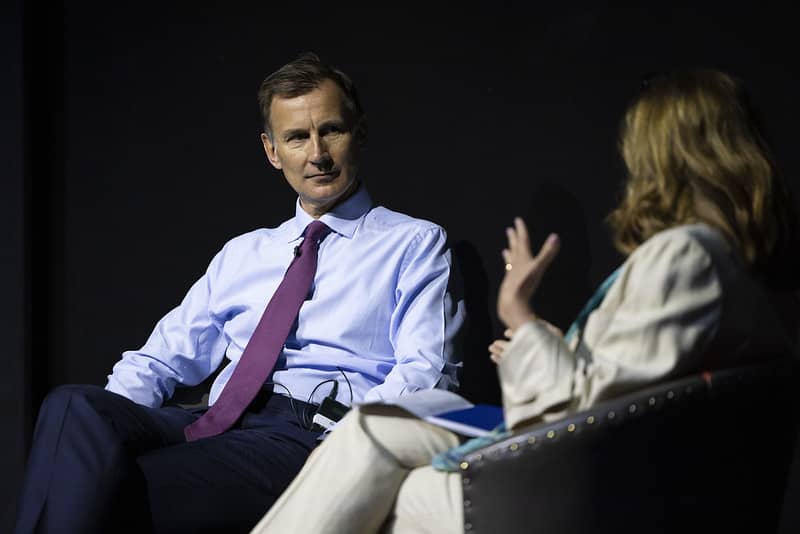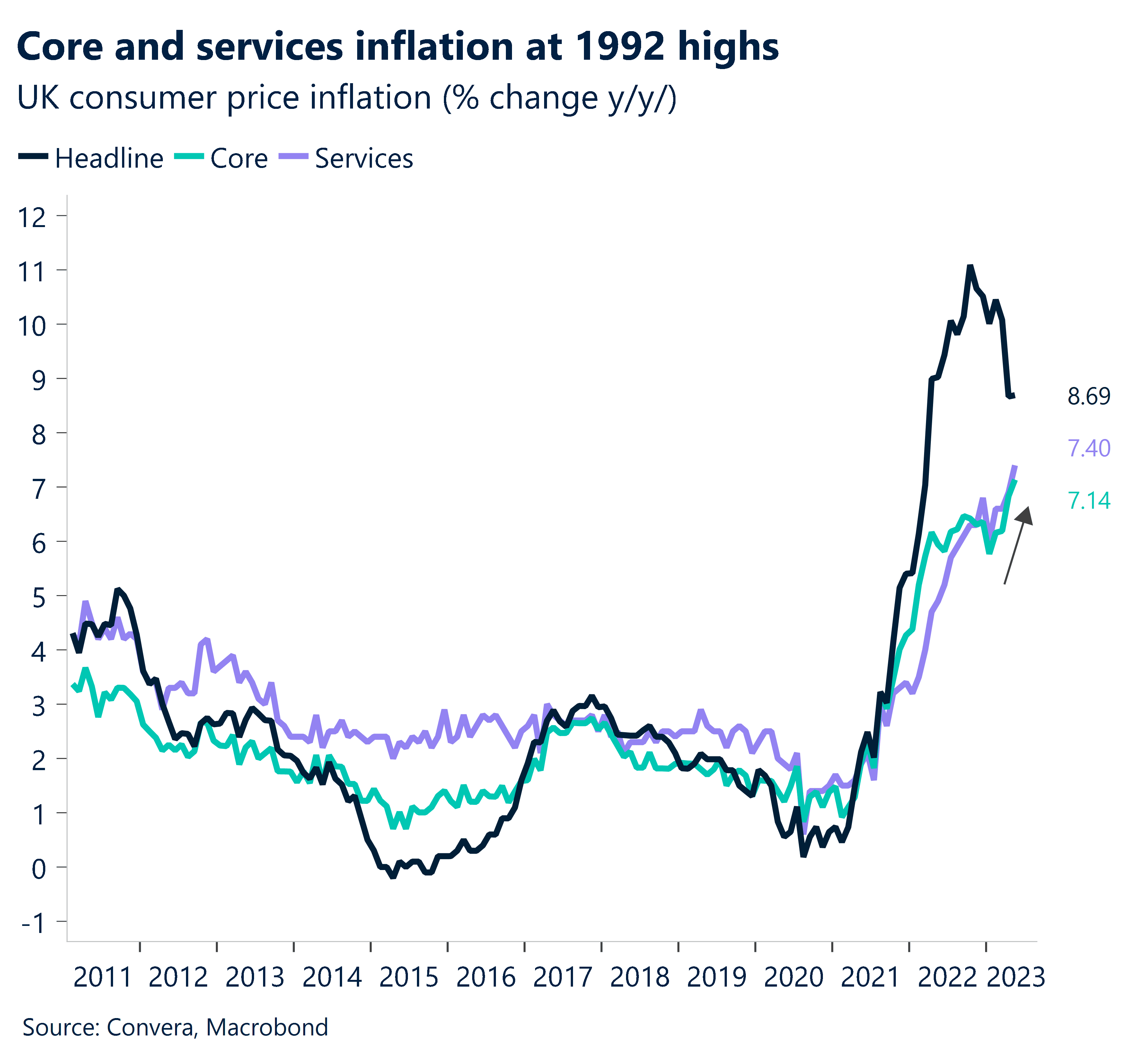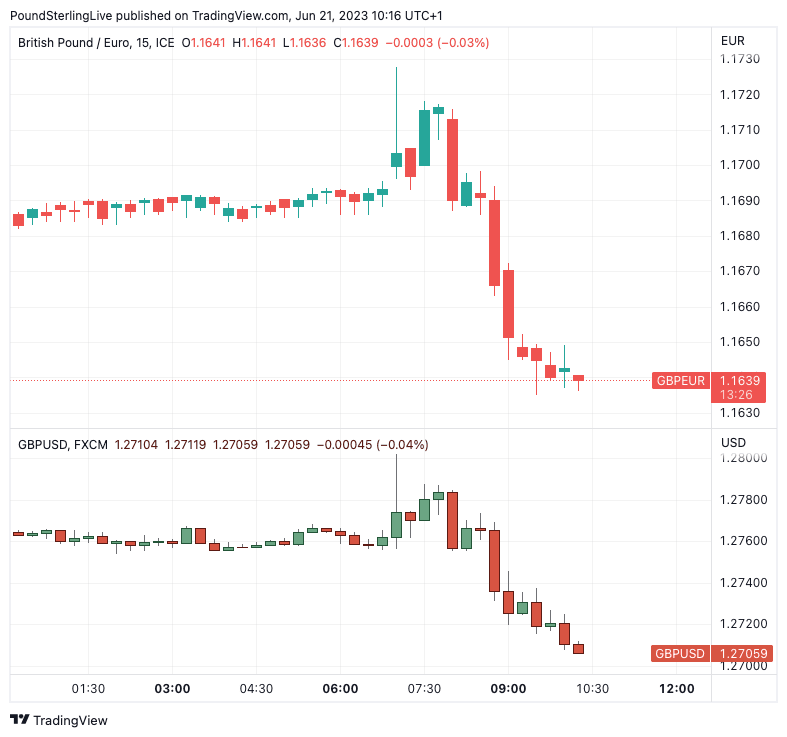Pound Sterling: Inflation Data Reaction Against Euro and Dollar
- Written by: Gary Howes
-
- GBP rises then falls in wake of UK inflation release
- Core inflation reaches a record
- But UK bond yields are relatively contained
- As PPI inflation falls sharply
- Suggesting pipeline pressures are easing

Above: UK Chancellor Jeremy Hunt was hoping for a sharp pullback in inflation in May, which was not realised according to official data.
Pound Sterling moved higher before steadily falling through the London morning following the release of UK inflation data that came in well above consensus expectations for a second consecutive month and cemented the market's expectations for further Bank of England interest rate hikes.
The decline in the Pound suggests the prospect for higher interest rates at the Bank of England is however now well understood and the propensity to really push expectations ever higher is fading, in short, this looks to be a classic 'sell the fact' FX reaction.
UK CPI inflation was unchanged in May at 8.7% year-on-year but the figure was above the consensus expectation for a reading of 8.4%. The surprise was driven by a 0.7% increase month-on-month, down from 1.2% in April but above expectations for a reading of 0.5%.
The all-important core CPI inflation accelerated from 6.8% y/y in April to read at 7.1% in May, a record high, blowing apart consensus expectations for 6.8%.
"Sterling spiked higher this morning following the higher-than-expected inflation outturn that will have added to concerns ahead of tomorrow’s UK interest rate update. The pound briefly touched new highs for the year against both the euro and the US dollar before falling back," says Rhys Herbert, an economist at Lloyds Bank.
Above: UK inflation, image courtesy of Convera.
The data will further bolster market expectations for the Bank of England to raise interest rates to as high as 6.0%, an expectation that is adding pressure on UK mortgage holders and prompting economists to warn of an impending economic recession.
The Bank will deliver its next interest rate rise and guidance on Thursday amidst signs it faces an inflation problem given signs inflation is not falling as fast as it projected. This is particularly the case with core inflation (which strips out external variables such as food and fuel) which the Bank can influence with interest rates.
"The latest data also shows signs of stubbornness in more domestically focused price pressures, most notably in the recent strength of private sector wage growth. As a result, another interest rate rise from the Bank of England looks like a done deal, with the prospect of at least one further rise in August to fully bring inflation under control," says Alpesh Paleja, Lead Economist at the CBI.
"The BoE meeting this Thursday is challenged by sticky inflation and strong wage growth, suggesting risks of a wage-price spiral," says David Alexander Meier, an analyst at Julius Baer Bank.
On paper, this can support the Pound which has been held aloft over recent months by rising UK bond yields, which are in turn a result of rising Bank of England rate hike expectations.
"The pound sterling remains well supported by rising rates and we recently revised up our 3-month forecast to EUR/GBP 0.85," says Meier (GBPEUR to 1.1765). "This forecast would see upside risks in case of a surprisingly hawkish BoE."
Following the inflation release the Pound to Euro exchange rate (GBPEUR) rose to 1.17 before retreating to 1.1649 by midmorning, and the Pound to Dollar exchange rate (GBPUSD) rose to 1.2770 before paring the advance to 1.2723.
Above: GBPEUR (top) and GBPUSD at 15-minute intervals showing recent price action.
"The FX impact of the CPI surprise was interesting. Sterling jumped but then rapidly erased gains: this probably signals how the room for a further hawkish repricing in the Sonia curve is limited and so are the positive implications for sterling of more data surprises," says Francesco Pesole, FX strategist at ING Bank.
The currency's reaction to the inflation data also confirms this to be a complicated release for investors as it potentially signals the UK has a unique inflation problem, which would mean the Bank of England is forced to raise rates which pushes UK bond yields higher, heaping more pressure on borrowers and potentially lengthening and extending the length of any incoming recession.
This would potentially be unsupportive of Sterling.
"Along with ongoing supply issues, UK inflation data doesn’t paint a picture of a booming economy. Tough for BoE to bring down this type of inflation without a hard landing. This is becoming an increasingly likely scenario. And one that’s bad for Pound Sterling," says Viraj Patel, FX & Global Macro Strategist at Vanda Research.
Economists do however maintain a view headline inflation will continue to fall over the course of the year, but the CBI's Paleja says it will still stand at double the Bank of England’s 2.0% target by December, making 2023 another difficult year for many households.
The two-year bond yield spiked to its highest level since 2008 at 5.11% following the release before falling back and will likely stay elevated until we see clear signs inflation is on a downward path.
"Today’s inflation figure will be a bitter pill to swallow for consumers, investors and the government. With CPI unchanged and core inflation rising, this confirms that the Bank of England has no choice but to raise interest rates tomorrow," says Marcus Brookes, chief investment officer at Quilter Investors. "Any thoughts of a pause, let alone rate cuts, seems incredibly premature, highlighting the economic muddle the UK faces."
Another important piece of data came in the form of the Producer Price Index inflation measure which shows factory gate prices are rapidly falling (PPI input inflation fell 0.5% m/m in May), in what amounts to a positive piece of news.
"Pipeline pressures in good prices are now easing markedly. This morning also saw producer price inflation figures published, and these showed a fall in input price inflation from 4.2% in April to just 0.5% in May, and a drop from 5.2% to 2.9% in producer output price inflation, all lower than even the most optimistic forecasts. It appears only a matter of time until consumer goods price inflation will head lower too," says Sandra Horsfield, an economist at Investec.
PPI is seen as a precursor to CPI inflation, therefore, falling prices here suggest lower headline inflation ahead.
This data set might also explain why UK bond yields have remained relatively contained and why the Pound has come off the boil.














